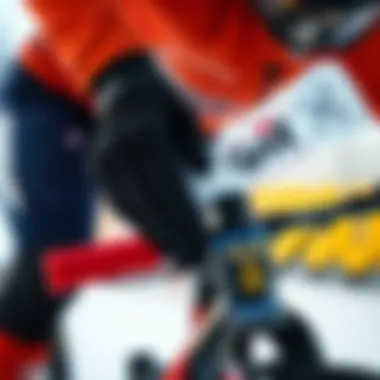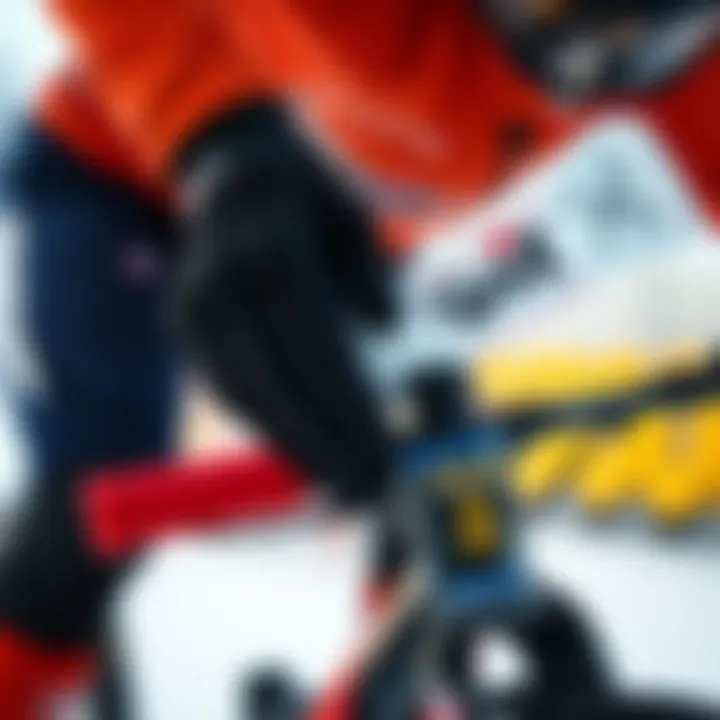Speed in Extreme Sports: Bones, Bearings, and Cream


Intro
Speed is the lifeblood of extreme sports, a force that fuels the passion and pushes the limits of athletes around the globe. Yet, while the fire to go fast blazes in the hearts of thrill-seekers, what often goes unnoticed are the subtleties that underpin this rush. In this exploration, we dive deep into the often-overlooked components: the bones of the athletes, the bearings that enhance performance, and the innovative creams that ensure longevity and safety in these adrenaline-pumping activities. Understanding the intersection of biology and technology in extreme sports reveals how performance can be optimized and risks managed.
Each element has its own role, much like a well-rehearsed dance. The bones provide the essential framework that supports everything from the simplest trick to the most extreme stunt. Bearings, on the other hand, are tiny mechanisms that allow for smooth motion and enhanced speed in equipment. Then there are the specially formulated creams designed to protect and invigorate the skin, ensuring athletes can compete at their highest potential without unnecessary hindrance from the harsh elements.
This article invites enthusiasts and professionals alike to explore these intricate details, enhancing not just performance but also safety and the overall experience in the world of extreme sports. Through a careful examination of these facets, we aim to shed light on how they contribute to a sport that thrives on the edge of risk and exhilaration.
Understanding the Anatomy of Bones
Bones are more than just the rigid frameworks that hold our bodies together; they play a pivotal role in athletic performance, especially in extreme sports. The structure of bones and their functionality underpin every twist, turn, and jump on the rugged paths athletes traverse. For those who push their physical limits—whether mountain bikers hurtling down a rocky slope or skateboarders defying gravity—understanding the anatomy of bones is foundational to grasping how human bodies endure the stress and demands of these adrenaline-filled activities.
The intricate composition of bones also has implications for strength, flexibility, and overall health. Healthy bones mean greater endurance and the ability to withstand high-impact landing scenarios that come with extreme sports. Therefore, both amateur thrill-seekers and seasoned pros must appreciate bone anatomy’s intricacies—not merely to enhance performance but also to minimize injury risks.
The Structure of Human Bones
Human bones are astounding marvels of biology, crafted not just for support but for resilience. Bones consist primarily of collagen, a protein that gives them flexibility, and minerals like calcium that provide strength. This unique fusion allows bones to handle stress; they aren’t merely static pillars but dynamic structures that adjust based on the forces they encounter.
Consider the femur, the largest bone in the body. It supports body weight and transmits forces during activities like running and jumping. Its long, cylindrical shape optimizes it for strength and efficiency. Moreover, the presence of bone marrow within is crucial, as it produces red blood cells essential for oxygen transport during rigorous physical exertion.
The interplay of cortical and trabecular bone types also deserves mention. Cortical bone is dense and protects the inner marrow, while trabecular bone—spongy and lightweight—permits flexibility and absorbs shock. This structure helps athletes absorb the impact that could otherwise lead to fractures or injuries.
Bone Density and Its Importance
Bone density is a critical factor for athletes involved in extreme sports. It refers to the amount of bone mineral in a given volume, influencing strength and resistance to fractures. Higher bone density equates to greater strength, which is crucial when considering the intense forces encountered in high-speed sports.
Factors affecting bone density include age, nutrition, and physical activity levels. For instance, weight-bearing exercises—like rock climbing or skateboarding—stimulate bone formation, leading to increased density. Conversely, injuries or prolonged periods of inactivity can lead to weakened bones, making recovery slower after an injury. This knowledge is invaluable for athletes looking to maintain peak performance; sensible training and nutrition, including calcium and vitamin D intake, play essential roles.
"Maintaining optimal bone density is like maintaining a fine-tuned piece of machinery: if one part wears down, the whole system struggles to perform."
Injury and Recovery in Extreme Sports
Injury is part and parcel of the extreme sports world, where the stakes are as high as the jumps athletes take. Common injuries include fractures and stress fractures stemming from high-impact activities. These injuries can sideline athletes for weeks or even months, significantly impacting their performance.
Recovery isn’t straightforward; it balances rest and rehabilitation. For instance, an athlete might be advised to refrain from weight-bearing activities until a fracture heals. This downtime can be frustrating, emphasizing the importance of understanding one’s body and the roles their bones play in overall athletic performance.
Equally, advancements in medical technology enable faster recovery through tailored rehabilitation programs and nutritional supplements catering to those specific needs—faster recovery means athletes can get back to doing what they love sooner.
Bearings: The Unsung Heroes of Speed
Bearings, though often overlooked, hold a significant position in the realm of extreme sports. They are the small yet mighty components that help reduce friction and provide smooth movement in various sporting equipment. Whether in skateboards, bicycles, or snowboards, bearings play a pivotal role in enhancing performance and ensuring safety for athletes pushing the limits of speed.
What Are Bearings?
Bearings are mechanical devices that facilitate motion between two parts. They allow for one part to rotate or move without hindrance over another. Typically designed to reduce friction, they are made up of balls or rollers and an outer shell, known as a raceway. As the inner and outer parts rotate, the balls roll between them, enabling a smoother operation. This reduces inertia, allowing athletes to achieve higher speeds with less effort.
In extreme sports, the efficiency of these components can mean the difference between a successful run and a mishap.
Types of Bearings in Extreme Sports
Various types of bearings are used in extreme sports equipment, tailored for specific applications. The most common types include:
- Ball Bearings: These are versatile and widely used. Found in everything from skateboards to mountain bikes, they offer a good balance between smoothness and load capacity.
- Roller Bearings: These are designed for heavier loads. They provide a larger surface area which translates to better performance in off-road conditions, essential for activities like BMX or downhill mountain biking.
- Ceramic Bearings: Offering less friction than stainless steel counterparts, ceramic bearings excel in high-speed applications. Their lightweight nature makes them popular among competitive athletes looking for every edge.
- Magnetic Bearings: These are high-tech options that minimize friction through magnetic levitation. While still being developed, they hold potential for future sporting technologies.
Choosing the right type of bearing depends on the specific sport and the conditions faced by the athlete.


Maintaining Bearings For Performance
Proper maintenance of bearings is crucial to ensure consistent performance. Neglected bearings can lead to decreased speed, instability, or even equipment failure. Here are a few tips for maintaining bearings:
- Keep Them Clean: Dirt and debris can hinder the movement of bearings. It's advisable to clean them regularly using a brush and solvent designed for the task.
- Lubrication: A sterling lubricant prevents wear and tear. A small amount goes a long way — ideally, use products specifically formulated for bearings to make sure they operate at peak efficiency.
- Check for Damage: Regularly inspect bearings for wear, nicks, or cracks. Any visual damage may be a sign that it's time for a replacement.
- Proper Installation: Sometimes, performance issues arise not from the bearings themselves, but from improper installation. Ensure they are fitted correctly for optimal functionality.
- Storage: If not in use for a long period, store bearings in a dry environment to prevent rust and degradation.
Keeping bearings in peak condition not only contributes to high performance but also plays a vital role in enhancing athlete safety. When every second counts, ensuring that these unsung heroes are well taken care of can make all the difference.
Speed Creams: A Closer Look
Speed creams play a pivotal role in the world of extreme sports, offering athletes a unique blend of performance enhancement and protection. In this high-octane environment, every second counts. Thus, the ability to reduce friction on equipment and improve glide through the air or on surfaces becomes crucial. Specialized creams are engineered to optimize movement while also safeguarding the skin, providing a dual purpose that is increasingly vital for advanced athletes. They have become not just a supplementary accessory, but a key to achieving peak performance.
Definition and Composition of Speed Creams
Speed creams are waxy substances, often formulated with various carrier oils and additives that work together to enhance the efficacy of the product. These creams typically contain:
- Natural Oils: Almond oil, jojoba oil, and coconut oil act as moisture-retaining agents while also contributing to the cream's lubricating properties.
- Silicone Compounds: These impart a slippery texture that minimizes friction, allowing for smoother gliding.
- Waxes: Carnauba wax or paraffin wax creates a barrier to protect against harsh conditions, be it water, dirt, or abrasion.
Essentially, speed creams are a concoction of natural and synthetic ingredients designed to improve not only performance but also the longevity of both the skin and gear in the extreme sports arena.
The Science Behind Speed Creams
The mechanics of speed creams can be broken down further into a multi-faceted approach:
- Reducing Friction: Friction is the silent enemy in any speed endeavor. The combination of oils and waxes in these creams effectively reduces contact between surfaces. This results in higher speeds and more efficient movements.
- Thermal Regulation: Speed creams often incorporate ingredients that help regulate temperature, acting as insulators against external elements. This is particularly important in extreme conditions where temperature fluctuations can impact performance.
- Enhanced Grip: The formulations can also create a grip surface that helps maintain control over equipment, whether it be a skateboard or skis, thus enhancing safety for athletes during high-speed maneuvers.
The scientific underpinning reveals that these creams do more than just make equipment slick; they create a synergy between the athlete's body and their gear, optimizing outcomes.
Application Techniques for Optimal Results
Using speed creams correctly can significantly influence performance. Here are some best practices for application:
- Clean Surface: Ensure that the area where the cream is to be applied is clean and dry. Remove any previous layers from gear to foster better adherence.
- Even Application: Spread a thin layer uniformly across the skated or rubbed-down areas. It’s better to build up application rather than slapping on too much at once.
- Timing: Apply the cream close to performance time. Doing so maximizes its effective properties by ensuring it remains activated during high-intensity sessions.
- Post-Performance Care: After use, it’s smart to clean off excess cream to prevent buildup that could impair gear performance later.
In summation, speed creams, when leveraged wisely, can amplify an athlete's competitive edge, ensuring that they’re not just fast but smart about how they achieve that speed.
The Interplay of Bones and Bearings
The connection between bones and bearings is not just a matter of anatomy or machinery; it’s about harmony and efficiency in extreme sports. Understanding how these two elements interact can help athletes optimize their performance while ensuring safety. The interplay between the structure of the human body, particularly the bones, and the mechanical nature of bearings reveals insights into the physics of speed, stability, and endurance needed for high-stakes activities.
Musculoskeletal System and Mechanical Elements
In extreme sports, the musculoskeletal system provides the necessary framework for movement and agility. Bones, muscles, tendons, and ligaments work in concert, enabling athletes to execute complex maneuvers. On the other side, bearings are the hidden mechanisms that reduce friction and enhance speed in equipment such as skateboards, bicycles, and even extreme sports sports gear like snowboards.
When these systems work together, they allow the athlete to maximize force output while minimizing energy expenditure. The bones must be strong yet lightweight, capable of bearing the impacts that arise during high-velocity activities. Simultaneously, the right bearings can provide a substantial advantage, allowing for smooth motion that translates to speed.
"The finest bearings are like a dancer on ice, gliding without a hitch while the skeletal structure guides their every turn."
Incorporating Technology with Anatomy
The integration of technology positively impacts both bone health and bearing efficiency. Advances such as lightweight carbon fiber materials and 3D-printed components are revolutionizing the design of sporting gear, enhancing performance while reducing injury risks. For instance, athletes increasingly use smart gear embedded with sensors to monitor their biomechanics. These insights reveal how their bones respond to impact and stress in real-time, enabling better training regimens and rehabilitation protocols.
Moreover, the design of bearings has evolved significantly. Manufacturers are constantly seeking to increase durability and speed through innovations like ceramic bearings, which are lighter and exhibit less friction than traditional steel alternatives. Hence, knowing how to pair the right bearing with appropriate equipment adjusts the transfer of force from the athlete's musculoskeletal system to the terrain, enhancing both performance and safety.
Performance Metrics in Extreme Activities
Understanding the performance metrics specific to extreme sports can shed light on how bones and bearings affect overall speed and effectiveness. Metrics such as acceleration, deceleration, and sustained force provide critical insights into how well an athlete performs under different conditions.


- Acceleration: This pertains to how quickly an athlete can go from stationary to high speed, heavily influenced by the integrity of their bones and the pivotal role of bearings during the launch phase.
- Deceleration: Just as essential, deceleration measures how effectively an athlete can slow down without losing control or risking injury, making knowledge of biomechanical limits and gear capabilities critical.
- Sustained Force: This measures how much energy a sportsperson can maintain through their routine. Here, the cumulative effects of bone strength and bearing efficiency come into play, as superior gear allows for extended periods of optimal performance without excessive fatigue.
Ultimately, these interactions illustrate that a delicate balance exists between the body’s biological mechanisms and the technological advancements in sport. Pairing knowledge of musculoskeletal health with cutting-edge bearings can dramatically enhance an athlete's overall performance, allowing them to push the boundaries of what is physically possible in extreme sports.
Safety Considerations in Extreme Sports
In the exhilarating world of extreme sports, safety isn’t just a precaution; it’s a fundamental pillar that can often be the difference between a thrilling success and a harrowing disaster. Athletes who engage in activities such as snowboarding, rock climbing, or BMX biking don’t just seek out adrenaline; they also need to navigate the hazards that accompany their pursuits. This section delves deep into pivotal safety measures that every participant must consider to mitigate risks and enhance performance during high-speed activities.
Protecting Bones Through Gear
To put it plainly, bones are the structural backbone of any human being. In extreme sports, they endure a barrage of physical stress and impacts that could easily lead to fractures or sprains. Therefore, a crucial aspect of athlete safety lies in the effective use of protective gear.
In addition to standard helmets, which reduce the risk of traumatic brain injuries, specialized equipment like knee and elbow pads can play a significant role in safeguarding the body's joints. For instance, snowboarders often wear impact shorts to cushion falls while skateboarders utilize wrist guards to protect their extremities during spills.
Furthermore, investing in high-quality materials that provide both comfort and protection can also help in maintaining mobility, thus allowing athletes to perform at their best without unnecessary restrictions. This balance between safety and performance is essential in creating an environment where athletes can focus on pushing their limits rather than worrying about injuries.
Bearing Maintenance and Athlete Safety
When it comes to extreme sports, well-functioning bearings are vital to ensuring not just performance, but also safety. Bearings control the movement and operation of the athlete’s equipment, whether it’s a skateboard wheel or a bike’s hub. If not maintained properly, bearings can malfunction, leading to unexpected crashes that can have severe consequences.
Regular maintenance routines should include cleaning and lubricating bearings. Athletes need to routinely check for any signs of wear or damage. A bearing that’s running smoothly contributes to better speed and control, which in turn enhances safety. A loose or damaged bearing, however, can lead to equipment failure at critical moments, endangering the athlete using it.
Here’s a basic checklist for maintaining bearings:
- Inspect for dirt and grime regularly.
- Clean with appropriate solvents to eliminate debris.
- Re-lubricate using specific lubricant mentioned by the bearing manufacturer.
- Replace damaged or overly worn bearings immediately to avoid hazards.
Caring for equipment ensures athletes can enjoy their sport without the constant worry of mechanical failure.
The Role of Speed Cream in Preventing Injuries
Speed creams, often overlooked, play an essential role in enhancing performance and minimizing injury during extreme sports. These specialized products contain ingredients that improve slide and glide, creating a smoother interaction between components, and even enhancing heat management within gear.
For athletes involved in activities like skiing or longboarding, applying speed cream appropriately can reduce friction between interfaces, thus preventing unnecessary burns or abrasions caused by heat.
Moreover, some formulations offer protective elements that aid in reducing irritation or chafing, proving particularly beneficial for long-duration activities. A proper application technique, for example, involves administering just the right amount and evenly spreading across the needed surfaces to achieve optimal results.
"Every athlete must remember that gear doesn’t take the place of caution; it complements it."
This philosophy underscores the importance of not only using speed creams but also understanding their limitations. A product may enhance performance, but it can’t replace the regimen of safety practices that every athlete must integrate into their routine. The careful blend of protective gear, bearing maintenance, and the intelligent use of speed cream reflects a robust approach to safety in extreme sports, ultimately paving the way for safer adventures and thrilling successes.
Case Studies: Athletes and Their Gear
In the world of extreme sports, every piece of equipment can mean the difference between a victory and a visit to the hospital. Thus, understanding the gear athletes choose is crucial for both performance and safety. Real-world insights from professional athletes reveal the relationships between their equipment selections, their personal experiences, and the results they achieve. Case studies furnish us with significant lessons on what works and what doesn’t, helping novices and veterans alike.
Profiles of Extreme Sports Athletes
To appreciate the impact of gear on performance, it’s essential to look at individual athletes who push the envelope in their respective sports. Consider the stories of riders like Travis Rice in snowboarding, known for his innovative tricks and the meticulous nature with which he approaches his equipment. For Rice, the choice of board, bindings, and boots isn’t merely about preference; it’s about how these elements contribute to his overall performance during competitions.
Similarly, in BMX, riders like Mat Hoffman put premium on the selection of handlebars and tires. His preference for lightweight materials enables him to pull off complex stunts while keeping the bike stable. Each athlete’s profile provides context for why their equipment choices matter—not just for style, but for functional outcomes in high-stakes environments.
Analysis of Equipment Choices
The analysis of equipment choices can unveil trends and preferences that enhance performance. Extreme sports athletes tend to gravitate towards brands they trust, much like how a chef prefers a favorite knife for precision. But beyond brand loyalty, there are characteristics that define what makes gear effective.
- Materials: High-performance materials such as carbon fiber or lightweight alloys provide both durability and speed.
- Fit: Equipment that fits well translates into better performance. For instance, a snug helmet can protect during falls while enabling optimal visibility.
- Technology: Advances in technology—like the incorporation of smart sensors in protective gear—have opened new avenues for performance analytics.
The varying choices across different sports highlight how specialized gear can elevate an athlete’s capabilities. Choices aren't made lightly; extensive testing often ensures the right fit for their unique style.
Performance Outcomes Based on Gear
What does gear ultimately yield in terms of performance? The connection between an athlete’s choices and their outcomes becomes evident through various metrics. For example, a study on skateboarders found that those equipped with high-quality wheels experienced a decrease in friction, allowing for greater speed and smoother landings. This leads to better scores in competitions, as judges reward finesse and control.


Moreover, research indicates that injuries can be significantly reduced with the right gear, such as knee pads that provide both mobility and protection. Statistics highlight that athletes using top-tier protective gear report fewer injuries compared to those with suboptimal equipment.
"The right gear doesn’t just enhance performance; it fundamentally keeps athletes in the game longer, allowing them to push boundaries that others simply cannot."
In essence, case studies of extreme sports athletes not only provide a window into the critical nature of equipment choices but also reveal how these decisions affect overall performance outcomes. Each athlete’s experience offers invaluable lessons that can inform both seasoned competitors and newcomers to the arena.
Emerging Trends in Bones and Bearings Technology
The rapidly evolving landscape of sports, especially extreme sports, has led to remarkable innovations in both bone health and bearing technology. Understanding these emerging trends is essential, as they not only enhance athletic performance but also prioritize safety and longevity in the grueling conditions athletes often face. This section digs into key advancements affecting bones and bearings, proving crucial for thrill-seekers and professionals alike.
Innovations in Bone Health for Athletes
Athletes push their bodies to the limits, putting immense stress on their skeletal systems. Recent advancements in bone health strategies are becoming game-changers. These innovations focus on two main areas: nutritional support and technological interventions.
One of the most noteworthy advancements is the understanding of bone remodeling through tailored nutrition. Research indicates that athletes can greatly benefit from a diet rich in calcium, vitamin D, and protein. Specialized supplements aimed at improving bone density are also gaining popularity. Consider, for instance, the use of collagen peptides, which not only enhance bone strength but also support joint health.
"Nutrition isn't just fuel; it's the foundation of athletic resilience."
In terms of tech, wearable devices now track bone health through sophisticated assessments of stress and strain. This information can guide athletes in their training routines, enabling optimal loads for strength building without risking injury. Additionally, breakthroughs in regenerative medicine, such as stem cell therapies, are paving the way for repairing damage to bones. By harnessing these modern methods, athletes can achieve longer, more durable careers.
Advanced Bearing Designs for Speed
When we dive into the world of extreme sports, bearings often take a back seat in discussions, yet they are crucial for maximizing these athletes' speed and efficiency. The latest designs in bearing technology are all about enhancing performance and reducing friction.
Cutting-edge bearings now incorporate materials like ceramic and specialized polymers, reducing weight and enhancing speed. Ceramic bearings, for instance, are not only lighter but also exhibit superior resistance to wear and tear. This means that athletes can maintain their top speed for longer durations without compromising on reliability.
Moreover, most recent innovations are focused on self-lubricating technologies. These bearings use advanced materials that reduce the need for manual maintenance, offering athletes the freedom to perform without worrying about their gear. Some bearings even come with smart tech capabilities that monitor their own performance, alerting users to potential issues before they jeopardize a race or a run.
The Future of Speed Cream Development
While bones and bearings propel athletes physically, speed creams have become an indispensable ally in the quest for ultimate performance. Speed creams are evolving, driven by both scientific research and athlete demand for greater efficiency and safety.
Current trends in speed cream development emphasize bio-compatible ingredients that enhance skin absorption without undesired side effects. For example, new formulations utilize natural extracts that not only provide lubrication but also possess anti-inflammatory properties. These creams help alleviate muscle strain and can even aid in injury prevention, making them essential for athletes who are prone to wear and tear.
Particular focus is also on personalization—creams tailored to specific sports or individual needs. Some manufacturers even encourage athletes to collaborate on formulations, ensuring that the end product is effective for their unique requirements. With the advent of advanced testing methods, such as nanotechnology, the benefits of speed creams are becoming more refined.
In summary, the trending innovations in bone health, bearing technology, and the evolution of speed creams are reshaping the way extreme sports athletes prepare for competitions. Keeping an eye on these developments not only prepares athletes for greater performance but also promotes safer practices that can extend their careers.
For further exploration on bearing technology, nutrition, and athletic performance, consider visiting Wikipedia or Britannica.
Closure: The Fusion of Biology and Technology
In the world of extreme sports, where speed reigns supreme, the convergence of biology and technology is more than mere enhancement; it's a necessity. This article explored how bones, bearings, and speed cream intertwine to redefine what's possible within high-stakes athletic pursuits. Understanding the intricate connections allows enthusiasts not only to optimize performance but also to ensure safety—essential components for every adrenaline junkie diving into the thrill of the chase.
What stands out is how human anatomy plays a crucial role alongside engineered materials. The musculoskeletal system, though resilient, is tested to its limits in extreme environments. Therefore, injuries can be devastating, but with the right equipment and knowledge, recovery becomes achievable. The article showcases this through various case studies that highlight elite athletes using cutting-edge gear and solutions tailored to their needs.
One notable aspect this exploration highlights is how technology, particularly advanced bearings, has revolutionized speed. Athletes are not just participating in extreme sports; they are part of a technological revolution that enhances their capabilities. From the precision mechanics of bearings to the specialized formulas of speed cream that reduce friction, each element works harmoniously with human physiology. By recognizing this fusion, athletes can attain performance levels that were previously considered unattainable.
"Safety and performance go hand in hand; understanding both can be the difference between victory and injury."
Reflections on Equipment and Performance
As we reflect on equipment choices, it becomes clear that informed decisions can directly impact performance outcomes. When examining the gear athletes choose, factors like material composition and ergonomic design come into play. A well-chosen helmet or protective padding can make all the difference in safeguarding the bones from severe impact. Conversely, even the most high-end bearings won’t function optimally if not maintained properly. The nuances of these selections drive home the point that integrating biology with technology results in a holistic approach to performance.
Athletes often become intimately familiar with their equipment, and it shows. The top-tier athletes know the feel of every piece of gear; they understand how their body interacts with it. It’s not merely about brand loyalty; it’s about creating a synergy that maximizes speed while minimizing risk. Some trial and error comes into play, but the ongoing learning curve is vital.
Paving the Way for Future Innovations
Looking ahead, the future of extreme sports certainly lies in continued innovation. Researchers and developers are constantly on the hunt for new materials and designs that can innovate existing products. For example, enhancing the flexibility and durability of bearings through advanced composites could significantly improve speed without compromising safety. Surprisingly, even small modifications in speed cream formulations could lead to breakthroughs that optimize skaters' glide or the smoothness of a bike ride on rugged terrain.
Furthermore, biomarkers and wearable technology can be integrated with traditional gear. Imagine athletes equipped with sensors that monitor bone stress or grip strength in real-time, providing instant feedback to adjust their style or intensity. This melding of the biological with the technological is where the future glimmers with promise.
In closing, the intricate balance of bones, bearings, and creams within the high-octane context of extreme sports together sets the stage for an exciting future. As technology continues to advance, and as athletes push their limits, we can only anticipate remarkable developments that will reshape the very foundation of these adrenaline-fueled pursuits. For those involved—whether as competitors or supporters of the movement—the journey is just beginning.







